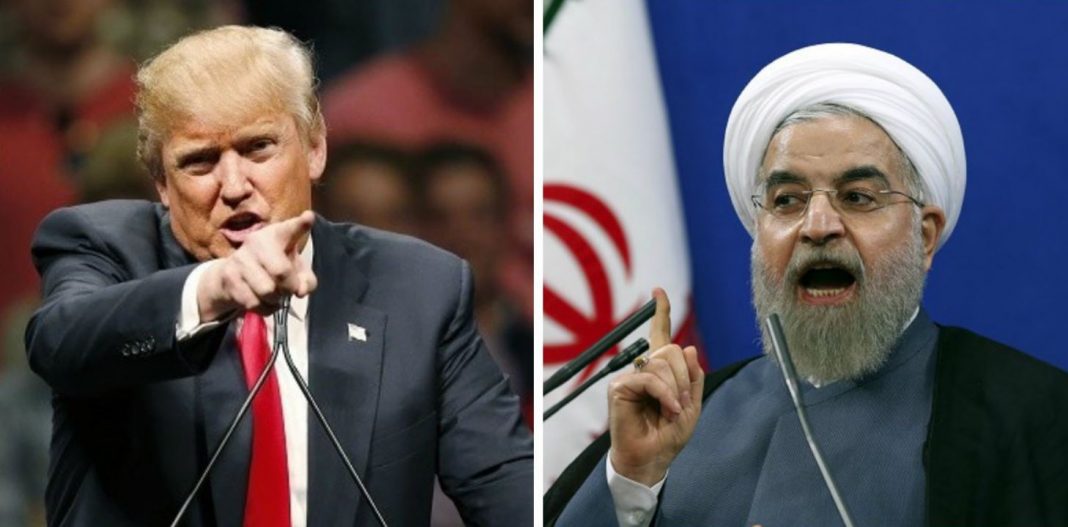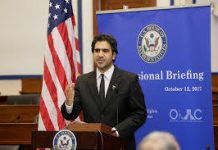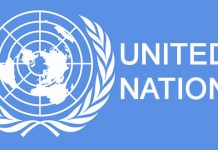Analysis/Why Trump May End Up Calling Rohani ‘Dear Friend’ After All
زفي برئيل/هآرتس: ربما لهذه الأسباب قد يتوقف ترامب عن مناداة روحاني يا صديقي العزيز
Zvi Bar’el/Haaretz/June 28/2019
Before heading to negotiations, Washington must set its red lines and clarify what it offers in return.
It’s been a few days since the Iranians downed an American drone, and no new attack has taken place in the Gulf, excluding attacks by Yemen’s Houthis on Saudi airports. The mysterious attacks on oil tankers (for one of which the United Arab Emirates still wants further proof that Iran perpetrated) have been replaced instead by fierce verbal exchanges.
Iran has diagnosed the White House as “mentally disabled” and threatened that if America attacks its sovereignty again, its response will be much harsher than downing a drone. U.S. President Donald Trump has vowed that if Tehran attacks American forces, it will be “the official end” of Iran.
In between, both sides stress that they don’t want war. Trump has repeatedly demanded direct talks with Iran, while Iran has rejected the offer because it doesn’t trust America.
But the clock hasn’t stopped ticking. On Thursday, Iran’s threat to increase its stockpile of low-enriched uranium beyond the 300 kilograms permitted by the nuclear deal has gone into effect. The next deadline is July 7, when Iran has threatened to start enriching uranium beyond the 3.7 percent level permitted by the agreement, perhaps even going to as high as 20 percent, if the deal’s European signatories don’t find a practical way to circumvent U.S. sanctions.
None of the relevant parties has a thought-out strategy for confronting Iran – not only over attacks in the Gulf, but primarily over its planned violations of the nuclear deal. French President Emmanuel Macron spoke repeatedly this week with both Iranian President Hassan Rohani and Trump, trying to ease tensions and reduce the danger of a confrontation. To Trump, he publicly promised that France opposes Iran obtaining nuclear weapons, and to Rohani, he talked up his efforts to launch a trading mechanism that would circumvent the sanctions, a mechanism that still hasn’t taken off.
Arm wrestling over the nuclear deal isn’t just taking place between Europe and the United States. Even within the U.S. administration, there’s no agreement on how to deal with Iran – either on the tactical or the strategic level.
One focus of disputes is whether to allow Iran to develop its nuclear program for peaceful purposes. The nuclear deal’s permissions are based on the Nuclear Non-Proliferation Treaty, which Iran has signed, as well as specific articles in the nuclear deal that allow it to purchase enriched uranium for research and electricity production – carried out at the Bushehr power plant and the Arak and Fordow facilities.
U.S. National Security Adviser John Bolton, who has taken the lead in forging Trump’s Iran policy with support from Republican senators Ted Cruz and Marco Rubio, wants Trump to cancel these permits and thereby complete America’s withdrawal from the nuclear deal.
Secretary of State Mike Pompeo, though also an uncompromising hawk, opposes scrapping the permits, out of fear that Iran would then produce the requisite amounts of enriched uranium itself. And Europe, all the while, is hoping that Washington’s continued issuing of permits indicates a willingness to keep at least parts of the deal in place, rather than scrapping it entirely.
For now, Trump has reissued the permits, but for 90 days rather than the 180 days stipulated in the agreement, after which he will reconsider. The contradiction of having withdrawn from the deal while continuing to honor certain parts of it doesn’t seem to bother him. After all, it’s minor compared to the contradiction of seeking negotiations with Tehran after withdrawing from the deal, which Iran was in full compliance with.
Perhaps Iran’s decision to increase its stockpile of enriched uranium will determine the fate of these permits. And if Trump decides to cancel them, he will merely bolster Iran’s argument.
In the absence of any diplomatic or military strategy aside from threats to attack Iran’s nuclear facilities – which Trump says he wants to avoid – it’s worth considering the impact of the new sanctions he’s imposed on Iran.
According to Treasury Secretary Steven Mnuchin, the decision to impose sanctions on Iran’s supreme leader, Ayatollah Ali Khamenei, stems from his status as the ultimate decision maker and the person in charge of the Revolutionary Guards, which Washington listed as a terrorist organization in April. Mnuchin said Khamenei controls assets estimated to be worth more than $200 billion, which are used, inter alia, to build up Iran’s armed forces and conduct military operations outside the country.
One could legitimately wonder why the administration didn’t impose sanctions on Khamenei previously. But the more interesting bit of information is that Iran has a huge financial cushion that could keep it afloat for a long time, even until the next U.S. presidential election.
Incidentally, the lack of governmental oversight and published data about where Khamenei’s slush fund – created by his predecessor, Ruhollah Khomeini – invests its assets will make it hard to implement these sanctions, especially since most of the money is deposited in Iran.
Sanctions on Foreign Minister Mohammad Javad Zarif, meanwhile, put Trump on a collision course with the United Nations, since they may result in Zarif being denied a visa to attend the UN General Assembly. That would be unprecedented, and it would violate the UN Charter.
But if Trump is clinging to sanctions as a way to convince Iran to agree to negotiate, it’s difficult to deduce what kind of agreement he’s aiming for. A year ago, Pompeo presented a list of 12 demands that Iran would have to comply with for Washington to lift the sanctions. Most analysts divide these demands into three categories.
First are the demands Iran could agree to, like disclosing the military nuclear program it ran before signing the nuclear deal. That information is already readily available from the International Atomic Energy Agency, although perhaps Washington is looking for an Iranian “confession.” Other demands in this category include allowing inspectors immediate access to any suspect Iranian facility (the nuclear deal already has such a provision, but it gives Iran 24 days to accede to such a request); releasing Americans and dual citizens from Iranian jails; ending Iranian aid to the Taliban in Afghanistan (which Iran says is a defense from Islamic State, but which Washington claims is enabling the Taliban to attack American forces); ceasing to threaten American allies, mainly Israel and Saudi Arabia; and ceasing to threaten passage through the Straits of Hormuz.
The second category consists of demands which Iran would have trouble agreeing to. These include ceasing its intervention in Iraq’s internal affairs and funding for Iraqi militias, ending aid to the Houthis in Yemen and Hezbollah in Lebanon, and withdrawing its forces from Syria.
The third category consists of demands Iran would certainly reject because they touch on core national security issues. These include demands to shut down its heavy water facility, eschew the processing of plutonium for military purposes, stop development and manufacturing of ballistic missiles capable of carrying nuclear warheads, and cut support for the Revolutionary Guards’ Quds Force, commanded by Qassem Soleimani.
Over time, however, the Pompeo demands have lost relevance. Trump hasn’t mentioned them when speaking of his desire to negotiate with Iran. It might actually have been possible to negotiate with Tehran over the lion’s share of these demands without quitting the nuclear deal, by building a relationship of trust based on Iran’s economic dependence on the West, rather than relying on sanctions and threats.
Nevertheless, Trump has never explained what his red lines are, which demands he would be willing to concede, and in exchange for what. For instance, would he agree to sell Iran fighter jets if it halts its missile program, which serves as a substitute for its virtually nonexistent air force? Is removing Iranian forces from Syria more important to him than Iran’s admission that it maintained a military nuclear program?
Moreover, what is he willing to offer Iran in exchange for all this, given that Iran is unlikely to be satisfied with just the removal of sanctions, already promised in the 2015 deal? Iran will undoubtedly demand potent sweeteners if it agrees to negotiate, so that its regime can present concrete achievements and not look as if it capitulated to American pressure.
For now, Tehran’s position is similar to that of the Palestinians – that even agreeing to negotiate with the Americans would be a capitulation, if not a defeat. But Iran knows how to devise magic formulas when it makes a policy decision. “I agree with what I termed years ago ‘heroic flexibility,’ because this approach works very well, and it’s necessary in certain situations, as long as we stick to our principles,” Khamenei said in 2013, laying the groundwork for negotiating the nuclear deal. Mansour Haqiqatpour, who is currently an advisor to the speaker of Iran’s parliament, said at the time that “correcting the relationship between Iran and the U.S. would crack the spine of the Zionist regime and of the reactionary regimes in the Middle East,” a truly paramount Iranian goal for which it might even be worth negotiating with Trump.




















